The top three technology business objectives, no matter the type of firm, for 2023, are improving client experience, adding more clients and deepening relationships with existing ones.
This is one of the major findings in a recent survey from Wealth Management IQ, the research division of WealthManagement.com. While the research reinforced the importance of technology across the advice industry, it nonetheless revealed a wide gap between those using it to set themselves apart and those simply looking to maintain.
In the survey, respondents were asked to classify themselves as either innovators, operators or laggards. Some 59% of respondents identified as operators, meaning firms that are invested in technology but mostly to improve operations and efficiency. Innovators, which comprised 28% of respondents, are firms that were investing in technology to differentiate themselves and seeking to provide improved client experience. And laggards, which made up 13% of those surveyed, do not make technology a priority or leverage what they already have.

Innovator firms most "embrace technology and maximize our technology investments"—53% of these firms gave themselves an "A" grade on this facet of the wealth management business. Meanwhile, only 10% of operator firms gave themselves an "A" grade, and a mere 2% of laggard firms did so.
Similarly, 87% of innovator firms view technology as either "very important" or "critical" to their ability to grow over the next five years, whereas this was the case for only 70% of operator firms and 59% of laggards.
It should come as little surprise that it was innovator firms who were most happy with the return on investment in their current tech stack; 51% of these firms were "very satisfied," while 27% of operator firms and only 15% of laggards had the same response.

Mark Bruno, managing director of Informa Wealth Management, said during a webinar detailing the survey results that self-described innovators are investing in technology to prioritize growth.
“Their business objectives are to be market dominators,” he said.
Operators were using technology more to improve automation, whereas innovators were using it to stand out from the crowd and engage with clients, said Iain Gillespie, head of product at TIFIN Wealth, during the webinar.
“Your growth is about connecting and expanding your revenues,” he said.
Data for the survey was collected between Oct. 21 and Nov. 1 from 409 respondents. Among them, 41% were from registered investment advisory firms, 19% came from regional or wirehouse brokerages, and 16% were from dually registered firms, with the remainder representing insurance broker/dealers, banks and credit unions. The mean of "personally managed AUM" equaled $337 million, while approximately a third of respondents managed $25 million in assets or less. Two-thirds of respondents identified as financial planners, advisors or investment advisors. Three-quarters were male, and over a quarter of the total respondents were between 50 and 57 years of age.
What it really all comes down to is improving relationships with better communication, said Shahyan Aly, principal product manager at SS&C Advent.
“When you communicate better with clients and you’re building your brand in a way that aligns with your needs and values, productivity sort of becomes a byproduct of that work,” he said.
Brandon Roth, senior project marketing manager at BILL, said offering clients experiences tailored to the industry in which those advisors are specializing was extremely valuable. He used the example of a firm specializing in e-sports professionals as clients.
“It better meets the need of that type of client," Roth said. "It also allows them to market themselves and differentiate themselves as advisory experts in that vertical.”
Shannon Rosic, the director of WealthStack content and solutions at WealthManagement.com, said firms were being pushed to use technology not only to align with their business objectives and strategies but also to deliver a personalized client experience. Rosic said clients were seeking advisors who use technology to allow them to interact more often.
“Tech is table stakes now,” said Rosic. “At the end of the day, the basis of an advisor-client relationship is trust,” she said.
Pressure to increase technological personalization in client communications was coming from outside the wealth management industry, said Gillespie, who used the example of Spotify "Wrapped," the personalized viral marketing campaign the company sends out each December. It’s compiled from a listener’s data, including favorite songs and genres and suggests new music based on that information.
“Personalization ultimately comes down to data, which is a way for us to build a persona about your clients and prospects in a way that engages them,” said Gillespie. “That standard is set by other industries. I think it’s aspirational for wealth management, but we can get there.”
The technology available today creates efficiencies and scalability for innovative advisors so they’re not having to focus on the productivity of the firm or the back office, said Roth.

Instead, advisors viewed financial planning, portfolio management, client communication tools and customer relationship management technology solutions as those that delivered the best ROI for them.
Meanwhile, digital workflow automation, performance analytics, risk management, client attraction and retention, business intelligence and compliance all ranked near the bottom.
Advisors could apply the concept of personalization to risk management, as well, if they were willing to frame it correctly, said Gillespie.
“'I am personalizing your portfolio to fall within your fear band and ensuring your portfolio is going to stay there;' if you can highlight that to a client, I think there is huge ROI potential,” said Gillespie.
Making risk management meaningful for the investor was “hugely important,” said Aly.
“That’s where you’re showing the investor your value as their guide in the journey,” he said.





